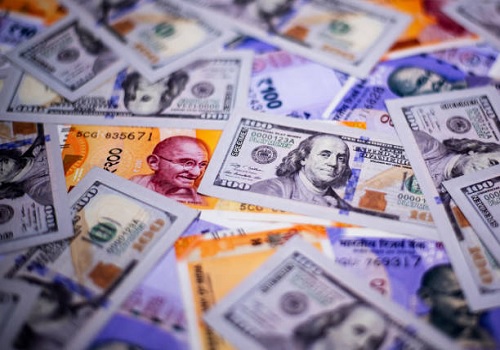Key gauges recoup early losses to end flat

Follow us Now on Telegram ! Get daily 10 - 12 important updates on Business, Finance and Investment. Join our Telegram Channel
In a highly volatile session, Indian equity markets recovered most of their early losses and ended around flat line on Monday on the back of weak global cues ahead of the FOMC meet. Markets opened gap down, as traders were concerned as the government data showed the growth of eight core infrastructure industries slowed down to 4.3 per cent in March against 12.6 per cent in the year-ago period due to a decline in the output of coal and crude oil. Sentiments remained down-beat with the Reserve Bank of India (RBI) in the Report on Currency and Finance for 2021-22 stated that the India’s economy may take more than a decade to overcome the losses emanating from the COVID-19 pandemic. The report has estimated the output losses during the pandemic period at around Rs 52 lakh crore. Some concern also came as India's foreign exchange (forex) reserves dipped by $3.27 billion to $600.42 billion for the week ended April 22, registering the seventh straight week of fall, as the Reserve Bank of India (RBI) appears to keep selling dollars to prevent a slide in the value of rupee amid the ongoing Russia-Ukraine conflict. Additionally, continuing its selling spree for the seventh consecutive month, foreign investors have pulled out Rs 17,144 crore from the Indian equity market in April amid fears of an aggressive rate hike by the US Fed that haunted such investors and dented sentiments.
However, the benchmark indices were able to erase most of the intraday losses, as some optimism remained among traders with the Finance Ministry stated that Goods and Services Tax (GST) collection in April 2022 touched the highest ever level of about Rs 1.68 lakh crore, up 20 percent from the year-ago period, on improved compliance. In April 2022, 1.06 crore GST returns in GSTR-3B were filed. The gross GST collection in April 2022 is an all-time high and Rs 25,000 crore more than the previous highest collection of Rs 1.42 lakh crore recorded in March. Some solace also came as after India's manufacturing sector activities witnessed faster growth in April amid quicker increases in production as well as factory orders, and renewed expansion in international sales. The seasonally adjusted S&P Global India Manufacturing Purchasing Managers' Index (PMI) rose from 54.0 in March to 54.7 in April, as a retreat of COVID-19 restrictions continued to support demand. Some support also came in as Department for the Promotion of Industry and Internal Trade (DPIIT) secretary Anurag Jain said foreign direct investment (equity) inflows into manufacturing surged 78% until February last fiscal to $20 billion, far exceeding the pace of rise in overall FDI, despite the pandemic blues.
On the global front, Asian markets ended lower in thin trading on Monday, as underlying sentiment was hit by concerns over inflation, the ongoing war in Ukraine and Covid-19 lockdowns in China. Disappointing factory activity data from China, the top trading partner for much of the region, also added to concerns about slowing global growth. China released data showing that factory activity in the country contracted for a second month to its lowest since February 2020 because of Covid lockdown. Separately, Caixin released its own manufacturing purchasing managers' index, revealing a second straight month of deterioration. European markets were trading mostly in red with growth worries and interest rate fears weighing on markets ahead of this week's FOMC meeting. Investors continued to monitor the war in Ukraine as EU leaders work on a Russian oil embargo.
Back home, pharma industry stocks were in focus as the commerce ministry said pharma exports have touched Rs 1,83,422 crore in 2021-22 against Rs 90,415 crore in 2013-14. Auto stocks were also in limelight reacting to their sales numbers. There were some reaction in edible oil industry stocks as the government approved the import of around 0.55 million tone (mt) of genetically-modified (GM) soymeal, a key ingredient in poultry feed. Auto stocks will be in limelight reacting to their sales numbers.
Finally, the BSE Sensex fell 84.88 points or 0.15% to 56,975.99 and the CNX Nifty was down by 33.45 points or 0.20% to 17,069.10.
The BSE Sensex touched high and low of 57,054.23 and 56,412.62, respectively. There were 11 stocks advancing against 19 stocks declining on the index.
The broader indices ended in red; the BSE Mid cap index fell 0.47%, while Small cap index was down by 0.87%.
The gaining sectoral indices on the BSE were Metal up by 0.77%, Basic Materials up by 0.28%, Utilities up by 0.26%, Power up by 0.22% and Realty up by 0.19%, while Consumer Durables down by 2.37%, Telecom down by 1.68%, IT down by 1.47%, Auto down by 1.19% and TECK down by 1.17% were the top losing indices on BSE.
The top gainers on the Sensex were Indusind Bank up by 4.17%, NTPC up by 2.54%, Power Grid Corporation up by 2.20%, Tata Steel up by 1.84% and HDFC up by 1.55%. On the flip side, Titan Company down by 2.95%, Wipro down by 2.74%, Tech Mahindra down by 2.01%, Infosys down by 1.70% and Asian Paints down by 1.27% were the top losers.
Meanwhile, expressing views over India’s economic situation, the Reserve Bank of India (RBI) in the Report on Currency and Finance for 2021-22 stated that the country’s economy may take more than a decade to overcome the losses emanating from the COVID-19 pandemic. The report has estimated the output losses during the pandemic period at around Rs 52 lakh crore. The Report said ‘the perturbations from repeated waves of COVID-19 have come in the way of sustained recovery and the quarterly trends in GDP essentially followed the ebbs and flows of the pandemic’.
Following a sharp contraction in the first quarter of FY21, the economic momentum progressively picked up till it was hit by the second wave in April-June 2021. Similarly, the impact of the third wave in January 2022 partially dented the recovery process. It noted that with the ongoing Russia-Ukraine war, the downward risks to global and domestic growth are getting accentuated through a surge in commodity prices and global supply chain disruptions. It said ‘the pandemic is a watershed moment and the ongoing structural changes catalysed by the pandemic can potentially alter the growth trajectory in the medium-term’.
As per the report, the pre-COVID-19 trend growth rate works out to 6.6% (CAGR for 2012-13 to 2019-20) and excluding the slowdown years, it stood at 7.1% (CAGR for 2012-13 to 2016-17). Taking the actual growth rate of (-) 6.6% for 2020-21, 8.9% for 2021-22 and assuming growth rate of 7.2% for 2022-23, and 7.5% beyond that, India is expected to overcome COVID-19 losses in 2034-35. It pegged the output losses for individual years at Rs 19.1 lakh crore, Rs 17.1 lakh crore and Rs16.4 lakh crore for FY21, FY22 and FY23, respectively.
The report has been authored by officials in the RBI’s Department of Economic and Policy Research. However, the central bank said that the findings and conclusions expressed in the report are entirely those of the contributors and do not represent the views of the banking regulator.
The CNX Nifty traded in a range of 17,092.25 and 16,917.25. There were 18 stocks advancing against 31 stocks declining, while 1 stock remain unchanged on the index.
The top gainers on Nifty were Indusind Bank up by 3.93%, Coal India up by 2.60%, Power Grid Corporation up by 2.11%, Tata Steel up by 2.04% and ITC up by 1.64%. On the flip side, Eicher Motors down by 3.43%, Apollo Hospital down by 3.40%, Titan Company down by 2.94%, Bajaj Auto down by 2.88% and Wipro down by 2.61% were the top losers.
European markets were trading mostly in red; France’s CAC decreased 82.35 points or 1.26% to 6,451.42 and Germany’s DAX decreased 84.10 points or 0.6% to 14,013.78, while UK’s FTSE 100 increased 35.36 points or 0.47% to 7,544.55.
Asian markets ended lower in thin trading on Monday ahead of an expected rate hike by the Federal Reserve by 50 basis points this week. Markets in Malaysia, Singapore, Taiwan, China, Hong Kong and Indonesia closed for holidays. Further, concerns over inflation, the ongoing war in Ukraine and Covid-19 lockdowns in China also weighed on market sentiments. Moreover, disappointing factory activity data from the world’s second largest economy also added to concerns about slowing global growth. Data showed that China’s official manufacturing Purchasing Managers' Index (PMI) fell to 47.4 in April from 49.5 in March, the lowest level since February 2020. South Korean shares dipped, even after survey data showed the manufacturing sector in South Korea expanded at a faster rate in April. Japanese shares declined following a sell off on Wall Street last week, while factory activity expanded at a slower pace from the previous month in April. Although, Japan's consumer confidence index rose for the first time in six months in April.
Above views are of the author and not of the website kindly read disclaimer










Tag News

Weekly Market Analysis : Markets strengthened recovery and gained nearly 2% in the passing w...





 320-x-100_uti_gold.jpg" alt="Advertisement">
320-x-100_uti_gold.jpg" alt="Advertisement">








